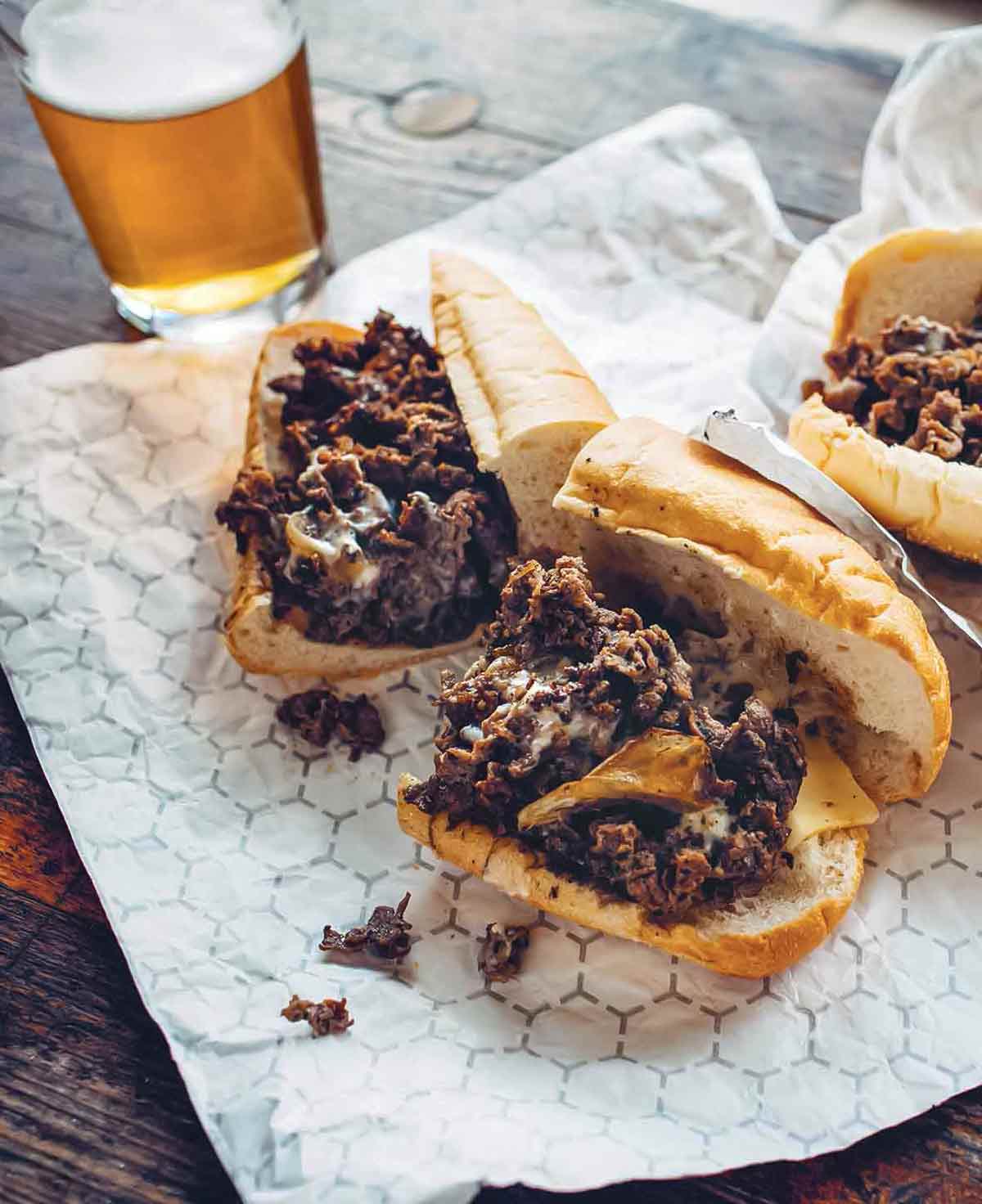
Philly cheesesteak. It’s essentially a sub roll piled high with thinly sliced and seasoned beef, caramelized onions, and melted cheese. What’s not to love? Well, folks have been debating the distinctions and nuances of various renditions of the Philly cheesesteak for decades—-the presence of anything other than onions and cheese, the type of cheese, the particulars of the roll, and that’s to name just a few. So while this undeniably delicious version won’t make everybody happy, it will make most folks unspeakably satisfied. Besides, people pleasing is overrated.–Angie Zoobkoff
*How do I slice my steak thin enough?
You can argue all day and night about what goes on a Philly cheesesteak. But if you ain’t got the meat right, then it’s not a Philly cheesesteak to start with. The essential element to the sandwich, beyond anything else, is incredibly thinly sliced meat. You can achieve this through a number of strategies, according to the authors of Eat Street. Here’s how… Grab a whole 18- to 20-pound rib eye at the meat market and lovingly carry it out of there like you’re Richard Gere and this piece of cow is Debra Winger at the end of An Officer and a Gentleman. Take it home, trim most of the fat cap, then blast chill it to an internal temperature between 26 and 28°F. Run it through a slicer at a level thin enough to almost see through it. Or…Find a butcher from that same market to do everything above in your chosen quantity (minus the Gere/Winger show). Or…Visit an Asian supermarket and grab the pre-packed super-thin beef slices used for Korean BBQ BBQ.

Philly Cheesesteak
Ingredients
- 2 pounds thinly and evenly sliced rib eye steak*
- Mild vegetable oil
- 1 pound white onions (about 1 large onion), peeled, halved, and sliced into thin half moons
- 1 to 2 tablespoons table salt, or more to taste
- 1 to 1 1/2 teaspoons garlic powder
- 1 to 1 1/2 teaspoons onion powder
- 1 pound sliced provolone or white American cheese
- Four (8-inch) sub rolls, split (you want a roll with a light crust but enough heft to stand up to the juices)
Instructions
- Heat a griddle to 375° to 400°F (190° to 204°C) or a couple large skillets on medium-high heat. The surface should read between 375° to 400°F (190° to 204°C). Slick your griddle or skillets with a little oil.
- On a portion of the griddle or in a large skillet, cook your onions for 2 to 3 minutes, turning them with your spatula, until they begin to sizzle. Splash some water on them, turn, scrape, and, when the water evaporates, repeat the process. Eventually you’ll have delicious softened or deeply browned onions, depending on your preference, 5 to 10 minutes.
- While you’re in onion land, mix the salt, garlic powder, and onion powder and put it in a shaker or a small dish. This is your secret seasoning. Like all secret seasonings, you can tell someone you’re taking the recipe to the grave while you’re actually just embarrassed it’s so simple.
- If using a griddle, lay your rib eye slices out across the surface in a single layer and let them sear, over medium-high heat for 2 to 3 minutes. Season generously with some of your seasoning magic. Flip the ribeye, season again but don’t use all of it, and begin to mix in the onions as the rest of the meat browns. If using a couple skillets, transfer the onions to a plate, wipe out the skillet, and return it to medium-high heat. Place a second skillet over medium-high heat. Lay some of your rib eye slices out across the surface of the skillets in a single layer. You’ll probably need to work in batches. Let them sear over medium-high heat for 2 to 3 minutes. Season generously with your seasoning magic but don’t use all of it.
- Flip the rib eye, season again if desired, and cook for another minute. If working in batches, transfer the cooked rib eye to a rimmed baking sheet, being careful to spread it out so the steak doesn’t steam, which will turn it tough, and cook the rest of the rib eye. When all the rib eye is cooked, divvy it up between the skillets and do the same with the onions. Begin to mix in the onions as the meat browns.
- Now it’s time to get all choppy-choppy with your spatula. Using the narrow edge of a long metal spatula, chop the rib eye into very small pieces. Then divvy it into 4 portions that resemble the size and shape of how they’re going to lay in the roll, which is to say sorta a rectangle.
- Drape 4 ounces provolone over each portion of meat. Squirt a tablespoon or so of water under the meat and cover just long enough for the cheese to become one with the meat, about 30 seconds.
- Game time! Take the spatula in your dominant hand and the open roll in your punier hand. Slide your spatula under the cheesy mess of onions and meat and flip it onto the roll. Devour immediately. Originally published October 7, 2016.
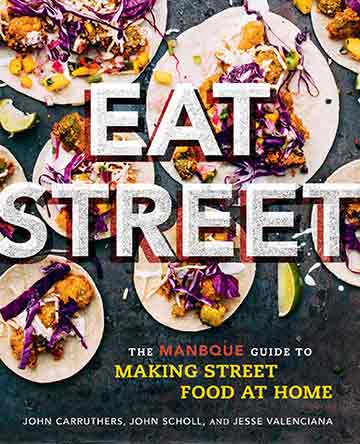
Nutrition
Nutrition information is automatically calculated, so should only be used as an approximation.
Recipe Testers’ Reviews
Philly cheesesteak research is fun! Realizing you can make it at home and make it your own is priceless. Having recently visited Philadelphia and sampled cheesesteaks, I already was in research mode and made a point to talk to the cheesesteak-wallah and watch my favorite one being made.
I knew the secret was thinly sliced rib eye, and am not shy about asking a butcher to slice it for me. If you go that route, I suggest you freeze the sliced meat in portions so you are ready to go whenever the spirit visits. I bought some nicely marbled rib eye at my local Asian market. I think real Wagyu or Kobe is probably over the top dollar-wise, but the Korean-style suggested or domestic Kobe-style or prime rib eye sliced thin for sukiyaki was just right.
My first version was straight to the recipe except for portion—8 ounces per person is too much meat for us, and I knew that from sharing cheesesteaks in Philly as well as my versions at home. I used 4 ounces per person, the meat coming from the fridge into the pan. I toasted a petite baguette sliced almost through lengthwise to go with and the sourdough roll stood up well to the meaty, cheesy goodness inside. Although I was cooking for just 2, I did the full quantity of onions and in a skillet, it took a bit longer to get to that perfect brown mess. I like keeping a water bottle handy to spray as you go along, capturing all the fond. I decided patience was called for, so 10 to 12 minutes later I was rewarded with a nicely evenly browned onions approaching caramelizing.
I reserved half for the next day in the fridge. Using a metal Chuan (flat edge wok spatula), and a second wooden spatula, I broke up the meat and mixed in the onions, then laid the provolone slices (the full whack of cheese) on top and covered. Perfect melt. Then I served them up on the toasted rolls.
The second day I used the prime rib eye that was marked for sukiyaki. This parcel (8 oz for the two of us ) I had frozen overnight, and took out 20 to 30 minutes before cooking. I feel the frozen meat (shaved or sliced thin) is much easier to work with, as you can actively flip it back and forth as it cooks and browns, scraping off the cooked bits. This is the method I learned watching the folks at Carmen’s in Reading Terminal Market. I also borrowed their addition of sliced golden peperoncini and used a mixture of sliced provolone and pepper jack. This was perfection for our taste.
This is a very forgiving recipe. I suggest freezing the meat overnight, then slightly thawing. It helps you gain better control when cooking it. Without a griddle, I was still able to make this work in a large cast iron skillet for two people. For a larger crowd, you’d want 2 pans or batches but I wasn’t able to test that.
We don’t have Philly cheesesteaks at our house very often because of a fresh pepper allergy. So when we saw this recipe without the peppers, we were very excited to try it. This is quite good.
We picked up a sirloin tip roast and partially froze it to slice as we have our own slicer. The sliced meat took 15 minutes total as we cooked in 3 batches over a medium-high heat before combining it with the onions. It was easy enough. We didn’t miss the peppers. I found it a little salty and one taster found the garlic almost too prevalent. When I make this again I’ll cut back on the salt in the seasoning to 2 or 3 tablespoons and only use 1 teaspoon each of the garlic and onion powder. Other than a couple minor changes a real keeper.
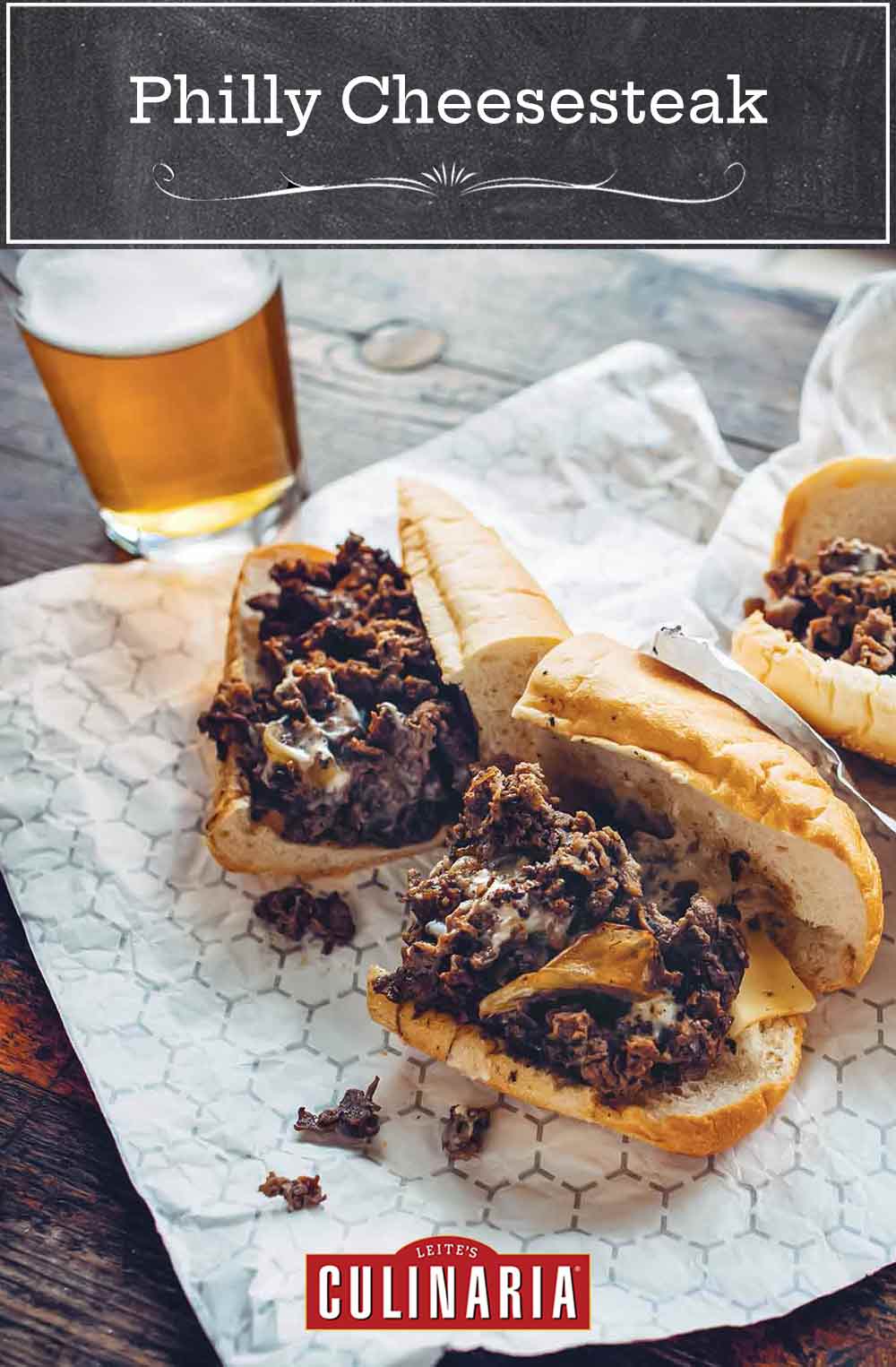



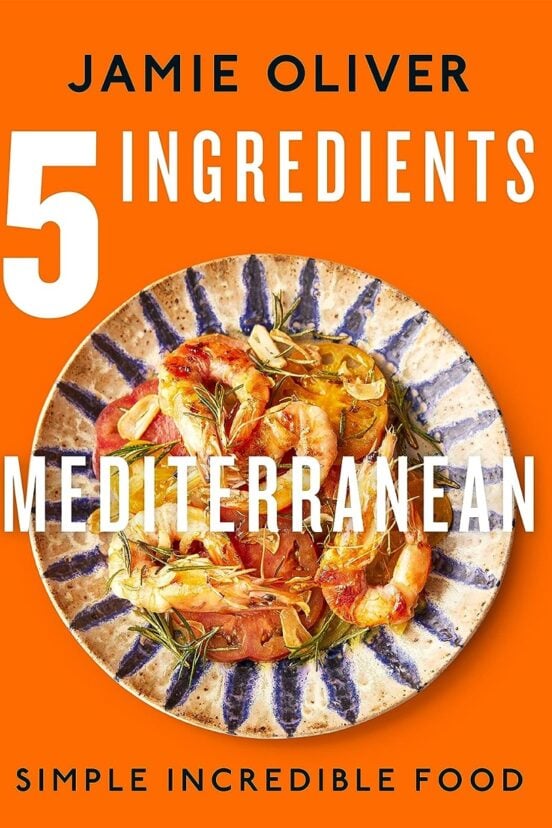
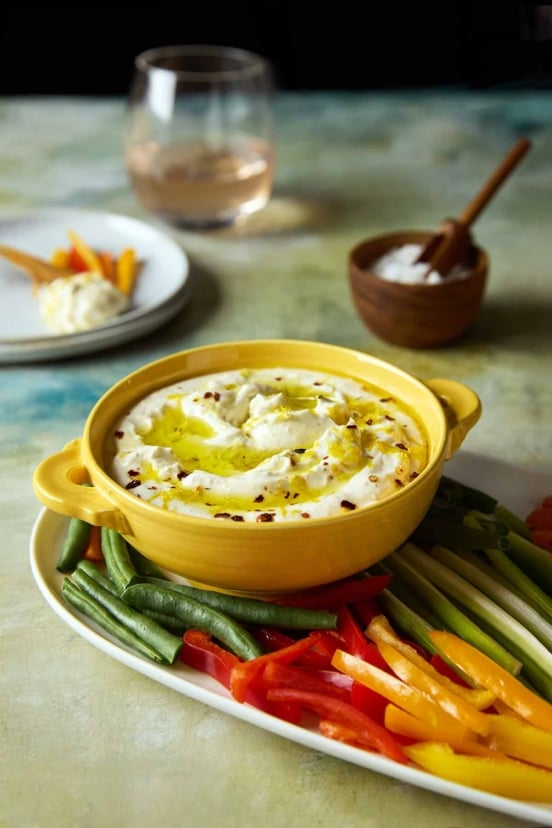
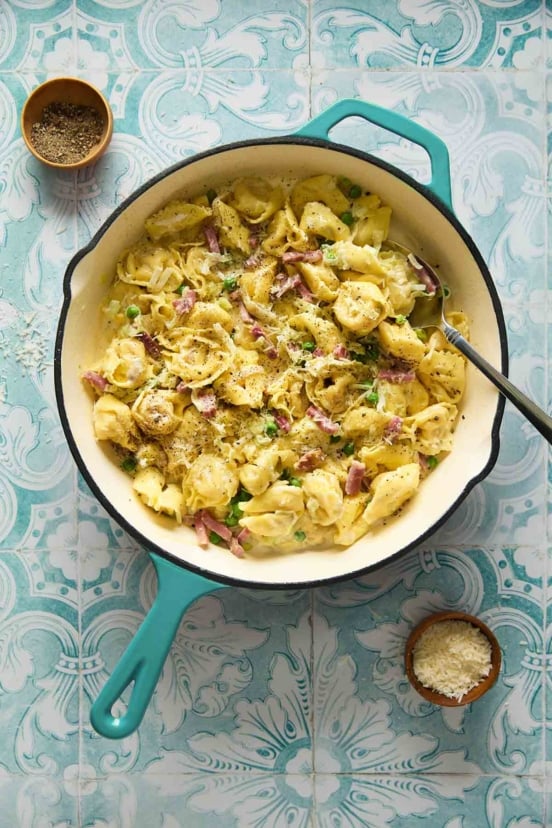









impossible to get decent sub rolls in a store can you help? do you make your own? care to give the recipe and tips for making them?
Ted, we don’t have “sub rolls” per se, but we do have this wildly popular hamburger roll recipe that you can easily shape into subs.
And Ted, you may also want to consider our baguette or pane francese recipe, shaped into smaller loaves, as that bread will be sturdier than our burger buns, which are phenomenal although more brioche-like. Speaking as someone who used to live in Philly, I suspect a sturdier bread such as one of these will make you quite happy…
Delicious! Overall this Philly cheesesteak is a very simple and quick recipe. Lunch was served in less than half an hour. The ribeye was an excellent choice due to its fat. I couldn’t find it thinly sliced at common grocery stores. Instead I found it at a Japanese grocery store alongside the meat for shabu shabu. I didn’t have a hard edge spatula. So I resorted to a pair of tongs and scissors. It did the work quite well—not unlike how one would slice meat at a Korean BBQ.
Thanks, Y. Chen Yuan, for your tips!
Absolute perfection. I recently purchased a 15 inch cast iron skillet – it called out to me on some subconscious cook’s level even tho it takes two hands to lift. It was perfect for the cornbread recipe on this site and it is great for this Philly cheesesteak recipe. I’ve made it twice using frozen beef tenderloin shaved thin with a giant sharp knife. (In my old age I am really getting into using large cookware and utensils, much easier to handle). I cook the onions on low with a cast iron lid cover, I use a fish spatula to lift the seared beef off the skillet and to flip, I transfer both to a cutting board and use two knives to crisscross chop and combine. The seasoning mix is spot on. I found provolone gets rubbery so I use shredded cheddar Monterey cheese and toast the bun. It doesn’t get easier or better than that. Oh, and I use Vidalia onions because they are in season and if I want to rev it up, a bit of Frank’s hot sauce.
Another great recipe from this site.
Magnificent, Marilyn! Many kind thanks for taking the time to let us know how much you love our recipes. We SO appreciate that!